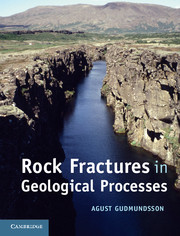Book contents
- Frontmatter
- Contents
- Preface
- Acknowledgements
- 1 Introduction
- 2 Stress
- 3 Displacement and strain
- 4 Relation between stress and strain
- 5 Loading of brittle rocks to failure
- 6 Stress concentration
- 7 Theories of brittle failure of rocks
- 8 Extension fractures and shear fractures
- 9 Displacements and driving stresses of fractures
- 10 Toughness and fracture mechanics
- 11 Field analysis of extension fractures
- 12 Field analysis of faults
- 13 Evolution of extension fractures
- 14 Evolution of faults
- 15 Fluid transport in rocks – the basics
- 16 Fluid transport in faults
- 17 Fluid transport in hydrofractures
- Appendix A Units, dimensions, and prefixes
- Appendix B The Greek alphabet
- Appendix C Some mathematical and physical constants
- Appendix D Elastic constants
- Appendix E Properties of some crustal materials
- Index
- References
7 - Theories of brittle failure of rocks
Published online by Cambridge University Press: 05 June 2012
- Frontmatter
- Contents
- Preface
- Acknowledgements
- 1 Introduction
- 2 Stress
- 3 Displacement and strain
- 4 Relation between stress and strain
- 5 Loading of brittle rocks to failure
- 6 Stress concentration
- 7 Theories of brittle failure of rocks
- 8 Extension fractures and shear fractures
- 9 Displacements and driving stresses of fractures
- 10 Toughness and fracture mechanics
- 11 Field analysis of extension fractures
- 12 Field analysis of faults
- 13 Evolution of extension fractures
- 14 Evolution of faults
- 15 Fluid transport in rocks – the basics
- 16 Fluid transport in faults
- 17 Fluid transport in hydrofractures
- Appendix A Units, dimensions, and prefixes
- Appendix B The Greek alphabet
- Appendix C Some mathematical and physical constants
- Appendix D Elastic constants
- Appendix E Properties of some crustal materials
- Index
- References
Summary
Aims
When rock is subject to higher stresses than it can sustain it fails. There are many modes of failure of rocks and other solids, but all belong primarily to one of two broad classes, namely ductile failure and brittle failure. However, some criteria apply both to strictly brittle rocks as well as to materials, such as granular media, that would normally be regarded as ductile. In fact, there is a gradation from strictly brittle (brittle fracture) to strictly ductile (plastic flow) in rocks and many other solids. In this chapter we discuss some of the main types of failure, focusing on the principal criteria for brittle failure, that is, failure through extension fractures and shear fractures. Brittle failure results in fractures which originate from stress concentrations (Chapter 6). The main aims of this chapter are to:
Define the concepts of strength and failure.
Explain the concept of a Coulomb material.
Define and explain the Coulomb failure criterion.
Explain and discuss some empirical failure criteria.
Discuss the basic elements of the Griffith theory.
Present the Griffith criterion for failure of rocks.
Failure and strength
Failure may be defined as the stress condition at which the solid either starts to flow or break. This stress condition thus defines the maximum stress or stress difference that the solid can sustain, that is, its load-bearing capacity. When the failure of the solid is through fracture formation, the failure is brittle. When the failure of the solid is through plastic flow, the failure is ductile.
- Type
- Chapter
- Information
- Rock Fractures in Geological Processes , pp. 190 - 232Publisher: Cambridge University PressPrint publication year: 2011



